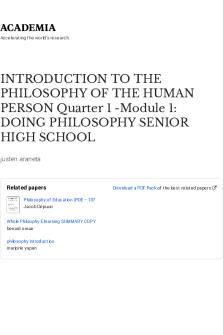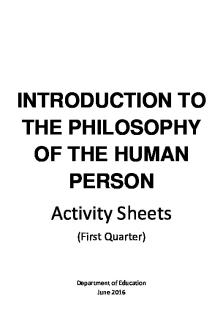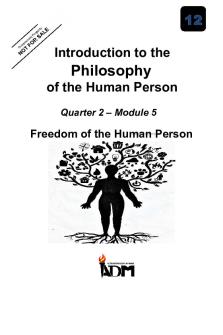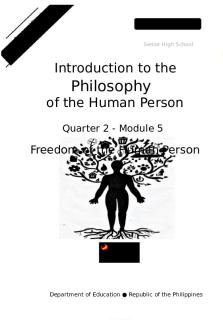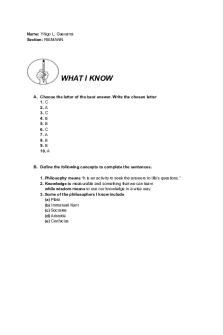Philosophy 1 Module 3 Human Person As An Embodied Spirit PDF

| Title | Philosophy 1 Module 3 Human Person As An Embodied Spirit |
|---|---|
| Author | THE BLINKS |
| Course | English |
| Institution | Leyte National High School |
| Pages | 25 |
| File Size | 1.1 MB |
| File Type | |
| Total Downloads | 38 |
| Total Views | 142 |
Summary
Download Philosophy 1 Module 3 Human Person As An Embodied Spirit PDF
Description
Senior High School
INTRODUCTION TO THE PHILOSOPHY OF THE HUMAN PERSON Quarter 1 – Module 3: THE HUMAN PERSON AS AN EMBODIED SPIRIT
Philosophy – Grade 11/12 Alternative Delivery Mode Quarter 1 – Module 3: The Human Person as an Embodied Spirit First Edition, 2020 Republic Act 8293, section 176 states that: No copyright shall subsist in any work of the Government of the Philippines. However, prior approval of the government agency or office wherein the work is created shall be necessary for exploitation of such work for profit. Such agency or office may, among other things, impose as a condition the payment of royalties. Borrowed materials (i.e., songs, stories, poems, pictures, photos, brand names, trademarks, etc.) included in this module are owned by their respective copyright holders. Every effort has been exerted to locate and seek permission to use these materials from their respective copyright owners. The publisher and authors do not represent nor claim ownership over them. Published by the Department of Education Secretary: Leonor Magtolis Briones Undersecretary: Diosdado M. San Antonio Development Team of the Module Writers: Arvin Derecho, Joana Doctor, James Lota Editor: Amalia C. Solis, Education Program Supervisor Reviewers: Michael S. Bernal, Paciano B. Ferrer, Gener C. Irinco, Nastasia V. Besin, Ernie Ronel Tirol Mabahague (Content) Marianne Carol Rodia Esteban (Language) Illustrator: Layout Artist: Management Team: Malcolm S. Garma, Regional Director Genia V. Santos, CLMD Chief Dennis M. Mendoza, EPS In Charge of LRMS Regional ADM Coordinator Maria Magdalena M. Lim, CESO V Schools Division Superintendent Aida H. Rondilla, CID Chief Lucky S. Carpio, EPS In Charge of LRMS
Printed in the Philippines by ________________________ Department of Education – National Capital Region Office Address: Telefax: E-mail Address:
____________________________________________ ____________________________________________ ____________________________________________ ____________________________________________
11/12 INTRODUCTION TO THE PHILOSOPHY OF THE HUMAN PERSON Quarter 1 – Module 3: THE HUMAN PERSON AS AN EMBODIED SPIRIT
Introductory Message For the facilitator: Welcome to the Introduction To The Philosophy of The Human Person (Grade 11/12) Alternative Delivery Mode (ADM) Module on The Human Person as an Embodied Spirit. This module was collaboratively designed, developed and reviewed by educators both from public and private institutions to assist you, the teacher or facilitator in helping the learners meet the standards set by the K to 12 Curriculum while overcoming their personal, social, and economic constraints in schooling. This learning resource hopes to engage the learners into guided and independent learning activities at their own pace and time. Furthermore, this also aims to help learners acquire the needed 21st century skills while taking into consideration their needs and circumstances. In addition to the material in the main text, you will also see this box in the body of the module:
Notes to the Teacher This contains helpful tips or strategies that will help you in guiding the learners.
As a facilitator you are expected to orient the learners on how to use this module. You also need to keep track of the learners' progress while allowing them to manage their own learning. Furthermore, you are expected to encourage and assist the learners as they do the tasks included in the module.
4
For the learner: Welcome to the Introduction to the Philosophy of the Human Person Alternative Delivery Mode (ADM) Module on The Human Person as an Embodied Spirit. The hand is one of the most symbolized part of the human body. It is often used to depict skill, action and purpose. Through our hands we may learn, create and accomplish. Hence, the hand in this learning resource signifies that you as a learner is capable and empowered to successfully achieve the relevant competencies and skills at your own pace and time. Your academic success lies in your own hands! This module was designed to provide you with fun and meaningful opportunities for guided and independent learning at your own pace and time. You will be enabled to process the contents of the learning resource while being an active learner. This module has the following parts and corresponding icons: What I Need to Know
This will give you an idea of the skills or competencies you are expected to learn in the module.
What I Know
This part includes an activity that aims to check what you already know about the lesson to take. If you get all the answers correct (100%), you may decide to skip this module.
What’s In
This is a brief drill or review to help you link the current lesson with the previous one.
What’s New
In this portion, the new lesson will be introduced to you in various ways such as a story, a song, a poem, a problem opener, an activity or a situation.
What is It
This section provides a brief discussion of the lesson. This aims to help you discover and understand new concepts and skills.
What’s More
This comprises activities for independent practice to solidify your understanding and skills of the topic. You may check the answers to the exercises using the Answer Key at the end of the module.
What I Have Learned
This includes questions or blank sentence/paragraph to be filled in to process what you learned from the lesson.
5
What I Can Do
This section provides an activity which will help you transfer your new knowledge or skill into real life situations or concerns.
Assessment
This is a task which aims to evaluate your level of mastery in achieving the learning competency.
Additional Activities
In this portion, another activity will be given to you to enrich your knowledge or skill of the lesson learned. This also tends retention of learned concepts.
Answer Key
This contains answers to all activities in the module.
At the end of this module you will also find:
References
This is a list of all sources used in developing this module.
The following are some reminders in using this module: 1. Use the module with care. Do not put unnecessary mark/s on any part of the module. Use a separate sheet of paper in answering the exercises. 2. Don’t forget to answer What I Know before moving on to the other activities included in the module. 3. Read the instruction carefully before doing each task. 4. Observe honesty and integrity in doing the tasks and checking your answers. 5. Finish the task at hand before proceeding to the next. 6. Return this module to your teacher/facilitator once you are through with it. If you encounter any difficulty in answering the tasks in this module, do not hesitate to consult your teacher or facilitator. Always bear in mind that you are not alone. We hope that through this material, you will experience meaningful learning and gain deep understanding of the relevant competencies. You can do it!
6
What I Need to Know On this module, you are expected to learn about the difference between Man, Human and Person, and their roles to the society. Today’s module would help us identify and recognize our own limitations and possibilities as we deal to various events in our lives. Are you ready to know more? Let’s go and dance in tune for the lessons that you will learn today.
The module will discuss the lesson about: •
The Human Person as an Embodied Spirit
MOST ESSENTIAL LEARNING COMPETENCIES: After going through this module, you are expected to: • •
Recognize how the human body imposes limits and possibilities for transcendence Evaluate own limitations and the possibilities for their transcendence
7
What I Know Here we go, let us remember and answer the following questions based from your prior knowledge. Don’t be afraid, this one is set to get you ready on our topic. I know you can do it! Let’s go! MULTIPLE CHOICES Directions: Read and analyze the questions and statements carefully. Encircle the letter of your chosen answer. 1. It is the term commonly used to represent the entire human race. A. Human being B. Human nature C. Man D. Person 2. It is a general term which refers to the deepest and natural behavior of a person that distinguish human from animals. It consists of collective traits that formed and considered the very essence of humanity. A. Human being B. Human nature C. Man D. Person 3. It is the term used to describe humans who are not just mere humans different from animals but with inherent birth rights and exact origin of his/her classification. A. Human being C. Human nature B. Human creature D. Human person 4. Carlo is a tall person with brown hair and brown eyes. What aspect of the human person is being described in the statement? A. Cognitive Self C. Psychological Self B. Physical Self D. Sociological Self 5. Marie is very cheerful and friendly to her classmates. What aspect of the human person is being described in the statement? A. Cognitive Self C. Psychological Self B. Physical Self D. Sociological Self 6. Which of the following is NOT an essential component of the human person? A. Conscience B. Mind C. Soul D. Spirit 7. Which of the following BEST describes the concept of embodiment? A. Human person is essentially his/her body and nothing more. B. Human person is essentially his/her spirit and nothing more. C. Human person is essentially the unity of his/her body and spirit. D. Human person is essentially a separate entity of the body and the spirit. 8. Which of the following experiences describe the concept of embodiment? A. Joy attaches a sentimental value to a pair of rubber shoes which was given by her mother. B. Kim associates love with hypothalamus, a part of the brain that is responsible for feelings. C. Ivy recalls a happy moment in her life and still feel the same happiness he felt at that moment.
8
D. Trina received a pat in her shoulder from her best friend and felt completely relieved at that moment. 9. Vincent loses his arm and leg due to a car accident. He loses a part of his physical body which makes up his physical identity. Which of the following statements is true about the concept of embodiment? A. Vincent can still be considered a human person despite losing a part of his identity. B. Vincent is not fully considered a human person since he lacks one aspect of his identity. C. Neither a nor b D. None of the above 10. A criminal who have committed a heinous offense can still be considered a human person despite of his cruelty and inhumane act. The statement is ___________. A. True, the dignity is still retained in spite of his actions because it is his inherent right. B. False, the dignity of humans are removed once they don’t treat other people just and right. C. Neither a nor b D. None of the above
Lesson
1
The Human Person as an Embodied Spirit
Do you still remember those days when you were playing outside your home? Playing with your friends or classmates all day long then waiting for a certain time for afternoon’s anime or fictional movies like Slamdunk, Flame of Recca, Dragon Ball, Princess Sarah, Cinderella and Snow White? Maybe you are wondering as to why we need to remember those days when everything was plain and simple. Our time after class were simply spent watching movies and playing inside or outside our home with brothers, sisters relatives, friends, friends of friends, classmates and schoolmates. You might ask me why? Why do we have to go back and remember our childhood days? What is the relevance of our childhood memories to our present times? You will find out, later.
9
What’s In Directions: Choose the BEST answer. 1. What is the branch of Philosophy that studies the method of acquiring and validating knowledge? A. Metaphysics C. Politics B. Ethics D. Aesthetics 2. Who is the founder of Phenomenology? A. Jean Paul Sartre C. Edmund Husserl B. Martin Heidegger D. Simone de Beauvoir 3. What point of view is central to the phenomenological method? A. First person point of view C. Third person point of view B. Second person point of view D. Absence of any point of view 4. What is the proper order of logical thinking? A. Concept-Perception-Inference-Proposition B. Proposition-Inference-Perception-Concept C. Perception-Concept-Proposition-Inference D. Inference-Proposition-Concept-Perception 5. How do you know if a statement is true according to the Correspondence theory? A. If you believe that it is true B. If philosophers believe that it is true C. If a statement is based on facts of reality D. If the statement is universally acknowledged to be true You did a great job! Yes, you heard it! You have honestly and patiently answered our review that could also help you understand our lessons ahead of you! Now you are ready for another journey, let us start the ball rolling to know more about the Human Person and to understand and recognize our human limitations and possibilities! What are you waiting for? Let’s go!
Notes to the Teacher The text is meant to engage the students in acquiring knowledge and determining the processes of knowing the truth by utilizing human reason. The role of the teacher is to simplify the process by giving relevant examples from daily life experiences.
10
What’s New Direction. On the blank spaces, analyze the concentric circles and write a short interpretation based on your understanding.
BODY MIND SPIRIT
_________________________________________________ _________________________________________________ _________________________________________________ _________________________________________________ _________________________________________________ _________________________________________________ _________________________________________________ _________________________________________________
What is It Are you aware that majority of us could recognize, define and use a certain word every day without knowing its role and true meaning? Do you believe that there is a big difference between MAN, PERSON, and HUMAN not only with the definition but its usage to the society as a whole? Yes, I know that these words are very common to us but this is the right moment for us to know more about it! Are you with me? Are you ready for our new journey? Let’s go!
The time has come! Let’s get started! Today’s journey will help us identify and understand the Human Person as an Embodied Sprit has something to do with defining Man, Human, Human Being, Person, Personhood and Human Nature (Abella, 2016). By definition, it is generally and commonly define to Man
represent the entire human race. A term used to refer for various classifications and species. For
Human
a living man, human is under the classification of Mamalia.
11
A term used to separate man from other Human Classifications Human Being
like animals. Refers to an individual who possess self-awareness, selfdetermination, rational mind, and the capacity to interact with
Person
other and with himself/herself. A general term refers to the state of being a person with unique,
Personhood
sacred and ethical status within him/herself. A general term refers to the deepest and natural behaviour of a person that distinguish human from animals. A collective traits
Human Nature
that formed and considered the very essence of humanity. Nobody can be considered man without human nature.
What is Human Person? Let’s find out! From the definition provided above, the human and the person, respectively, are defined with classified origin of species and persons with birth rights. Human person is someone with an exact origin of his/her classification. From the biblical perspective, we came from Adam and Eve. For Science, we came from an Ape under the Class:
Photo from: https://www.quora.com/Are-souls-realWhat -is-a-soul?no_redirect=1
Mamallia.
Human person from time after time learned how to live beyond what was traditional through the various human evolutions from Hominid to Homo Sapiens or the Modern Man people learn the concept of power, politics and economics. These reasons served as basis which led to a more structured political and economic system. Thus, rights of an individual is considered. A human person is typically with a body which is tangible and has a three components composed of SOUL, MIND and SPIRIT. Also, he or she is entitled and granted rights and privileges by the state which he or she legally belong.
12
There are two general kinds to distinguish a human person: The Cognitive Self and the Physical Self. The Cognitive Self (something within and cannot be physically seen) is the essential components of a human persons that deals with THE WHAT OF A PERSON which includes human persons’ belief, desire, dreams, and intentions. The other is one is the Physical Self (something can be seen in his/her physical appearance) which deals with the essential features of the human way of life or THE WHO OF A PERSON which includes his/her body type, strength and appearances.
What is Embodied Spirit? Let’s find out! Embodied spirit is an animating core living within each of us. It is known to be the driving force behind what we actually think, do and say. It is indeed the reflections of our total being by which our sensations lead to our
human
feelings,
emotions
and
decision. The usual and known connotation that comes to our mind when we hear the word “embodied” is always materialized or became Photo from: https://angelsandcelestials.tumblr.com/post/103122385263/22signs-that -you-are-embodying-your -higher -self
flesh (with physical form). Thus, when we say
“embodied spirit”, we normally believed and conclude of a spirit becoming flesh. In the context and views of Christian philosophy, the embodiment of the spirit particularly refers to the inseparable union of human body and soul. Inseparable which also means the body and soul work together at all times. Hence, we can safely say that “embodied spirit” that the body is not separate from the soul, just as the soul is not separate from the body.
What is Human Person as Embodied Spirit? Let’s find out! As an embodied spirit human beings demonstrate these following qualities (Abella, 2016): 1. “Self- awareness refers to person having a clear perception of oneself, including his or her thoughts, emotions, identity, and actions (Abella, 2016).” It is the ability of one’s consciousness to look inward thus discovering the presence of a self. 13
The self is the subject that thinks, feels and acts. It is your I amness (Wilber, 2006). The self enables a person to experience an inner world of dreams, thoughts, imagination, fantasy (Abella, 2016). Thus, the self represents man’s interiority (loob in Filipino). 2. A human person is able to connect and interact with another person, an animal or an inanimate object. We call this externality. So even though human beings have interiority they are not trapped inside their heads. They are able to go beyond their limited selves and embrace others.
3. We are not determined by others. Because we have interiority; we can direct the course of our own life. This is what we call self-determination which is “the capability of persons to make choices and decisions based on their own preferences, monitor and regulate their actions, and be goal oriented and self-directed” (Abella 2016) Thus human beings are free. However since our actions are based on our decisions we have to realized that every decision has a c...
Similar Free PDFs

Philosophy and human existence
- 2 Pages

The Human Person in Society
- 12 Pages

Human Person and Values Development
- 10 Pages
Popular Institutions
- Tinajero National High School - Annex
- Politeknik Caltex Riau
- Yokohama City University
- SGT University
- University of Al-Qadisiyah
- Divine Word College of Vigan
- Techniek College Rotterdam
- Universidade de Santiago
- Universiti Teknologi MARA Cawangan Johor Kampus Pasir Gudang
- Poltekkes Kemenkes Yogyakarta
- Baguio City National High School
- Colegio san marcos
- preparatoria uno
- Centro de Bachillerato Tecnológico Industrial y de Servicios No. 107
- Dalian Maritime University
- Quang Trung Secondary School
- Colegio Tecnológico en Informática
- Corporación Regional de Educación Superior
- Grupo CEDVA
- Dar Al Uloom University
- Centro de Estudios Preuniversitarios de la Universidad Nacional de Ingeniería
- 上智大学
- Aakash International School, Nuna Majara
- San Felipe Neri Catholic School
- Kang Chiao International School - New Taipei City
- Misamis Occidental National High School
- Institución Educativa Escuela Normal Juan Ladrilleros
- Kolehiyo ng Pantukan
- Batanes State College
- Instituto Continental
- Sekolah Menengah Kejuruan Kesehatan Kaltara (Tarakan)
- Colegio de La Inmaculada Concepcion - Cebu



